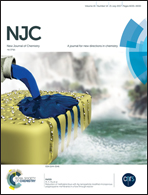Microwave-induced combustion: towards a robust and predictable sample preparation method†
Abstract
Sample preparation methods based on combustion for further element determination in carbon-based samples are normally performed using an excess of O2 in order to ensure the complete oxidation of the organic matrix. However, experimental conditions such as O2 pressure and sample mass are commonly selected based on empirical knowledge. In the present work, in order to provide a guide for planning combustion reactions using microwave-induced combustion, a mathematical model was proposed based on the sample composition to calculate the amount of O2 required for each matrix. A critical study was performed using selected matrices such as graphite (C), anthracene (C14H10), polypropylene (C3H6)n, microcrystalline cellulose (C6H10O5)n, saccharose (C12H22O11), dibenzothiophene (C12H8S), carbazole (C12H9N), carbamazepine (C15H12N2O), and methionine (C5H11NO2S) in order to demonstrate the feasibility of the proposed model. The obtained results showed that our prediction model allowed for more efficient digestion of graphite, hydrocarbons, and methionine (compounds presenting O, N, and S) using only 10 ± 2% of O2 excess. For samples more difficult to burn, such as dibenzothiophene and carbazole, a relatively higher excess of O2 was required (30%). Digestion efficiency was evaluated by determining the residual carbon content (RCC) in the final solutions, which was always lower than 0.15%, even for sample masses as high as about 1500 mg digested in relatively small vessels (78 ± 1 mL). The proposed model allowed faster development of combustion methods for digesting the greatest possible sample mass, resulting in improvements in the limits of quantification in a robust and safe way. The costs related to such analyses could be reduced and improvements in analytical operations could be highlighted as important features by using the prediction model for combustion processes assisted by microwave radiation.



 Please wait while we load your content...
Please wait while we load your content...